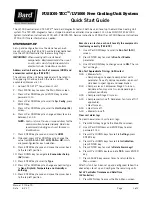
10
chemical contaminants are detergents, bleaches,
aerosol sprays, cleaning solvents, and a wide variety
of commercial and household products.
WARNING:
Combustible air must not be drawn from a
contaminated atmosphere. Excessive exposure
to contaminated combustion air will result in
safety and performance related problems.
CIRCULATING AIR SUPPLY
WARNING:
Products of combustion must not be allowed to
enter the return air ductwork or the circulating air
supply. Failure to prevent products of combustion
from being circulated into the living space can
create potentially hazardous conditions including
carbon monoxide poisoning that could result in
personal injury or death.
All return ductwork must be adequately sealed,
all joints must be taped, and the ductwork must
be secured to the unit with sheet metal screws.
When return air is provided through the bottom
of the unit, the joint between the unit and the
return air plenum must be air tight.
The roof curb or cement pad on which the unit is
mounted must provide sound physical support of
the unit with no gaps, cracks, or sagging between
the unit and the curb or pad.
Return air and circulating air ductwork must
not be connected to any other heat producing
device such as a fi replace insert, stove, etc.
Doing so may result in fi re, explosion, carbon
monoxide poisoning, personal injury, or property
damage.
This unit is designed only for use with a supply and return
duct. Air ducts should be installed in accordance with all
applicable local codes and the standards of the National
Fire Protection Association “Standard for Installation of
Air Conditioning Systems” (NFPA 90A), and “Standard for
Installation of Residence Type Warm Air Heating and Air
Conditioning Systems” (NFPA 90B).
Design the ductwork according to methods described
by the Air Conditioning Contractors of America (ACCA)
Manual D. The ducts must be properly sized not to exceed
0.2 inches WC pressure drop at 400 scfm per nominal
ton of cooling capacity.
Ductwork should be attached directly to the unit fl anges
for horizontal applications. On roof curb installations the
ducts must be attached to the curb duct supports, not
the unit.
It is recommended that the outlet duct be provided with
a removable access panel. This opening should be
accessible when the unit is installed in service and shall
be of a size such that the smoke or refl ected light may
be observed inside the casing to indicate the presence
of leaks in the heat exchanger. The cover for the opening
shall be attached in such a manner as to prevent leaks.
If outside air is utilized as return air to the unit for ventilation
or to improve indoor air quality, the system must be
designed so that the return air to the unit is not less than
50°F (10°C) during heating operation. If a combination
of indoor and outdoor air is used, the ducts and damper
system must be designed so that the return air supply to
the furnace is equal to the return air supply under normal,
indoor return air applications.
Unconditioned Spaces —
All ductwork passing through
unconditioned space must be properly insulated to
minimize duct losses and prevent condensation. Use
insulation with an outer vapor barrier. Refer to local codes
for insulation material requirements.
Acoustical Ductwork —
Certain installations may require
the use of acoustical lining inside the supply ductwork.
Acoustical insulation must be in accordance with the
current revision of the Sheet Metal and Air Conditioning
Contractors National Association (SMACNA) application
standard for duct liners. Duct lining must be UL classifi ed
batts or blankets with a fi re hazard classifi cation of FHC-
25/50 or less. Fiber ductwork may be used in place of
internal duct liners if the fi ber ductwork is in accordance
with the current revision of the SMACNA construction
standard on fi brous glass ducts. Fibrous ductwork and
internal acoustical lining must be NFPA Class 1 air ducts
when tested per UL Standard 181 for Class 1 ducts.
Horizontal to Down fl ow Conversion —
The unit is
shipped ready for horizontal duct connections. If down fl ow
ducts are required, the unit must be converted following
the steps below for both the supply and return ducts.
1. Locate the duct cap inside the duct openings and
remove the screw holding it in place.






























